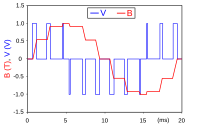
Photo from wikipedia
Voltage-gated sodium channels are transmembrane proteins that are responsible for the rapid depolarization that elicits the upstroke of action potentials in neurons and cardiac cells. Molecular cloning techniques have identified… Click to show full abstract
Voltage-gated sodium channels are transmembrane proteins that are responsible for the rapid depolarization that elicits the upstroke of action potentials in neurons and cardiac cells. Molecular cloning techniques have identified nine related voltage-gated sodium channels subtypes with distinct biophysical properties, interacting proteins, and cellular patterns of expression that are involved in electrical signaling. The goal of many research groups is to target specific sodium channels subtypes to develop selective inhibitors that could, in theory, produce safer and more efficacious drugs. To address compound sodium subtype profiling, we used a two-pulse state-dependent protocol to develop a sub-type specific sodium channel (hNav1.1 to hNav1.8) panel on the QPatch HT patch clamp system. Additionally, we tested three stimulus protocols on hNav1.5 with known sodium inhibitors: 1) CiPA protocol for cardiac safety testing (tonic), 2) two-pulse state-dependent protocol (inactivation-dependent), 3) three-pulse protocol (tonic, inactivation-dependent, and V1/2 dependent inactivation). The CiPA protocol identified state-independent compounds (e.g. Flecainide) within three-fold of published literature values, but didn’t identify state-dependent compounds such as Lidocaine. The two-pulse protocol identified both state-dependent and independent compounds at pulse 2 with IC50 values within 4-fold published literature values. Data from the first two pulses of the three-pulse protocol had comparable pharmacology to the two-pulse protocol. The functional activity from V1/2 inactivation (a delayed 3rd pulse) was less predictive of state-dependent inhibition than the two-pulse protocol but may reflect the in vivo inhibition. The hNav1.x panel using the two pulse protocol can be useful to profile target identification, selectivity and state-dependence of novel compounds. (QPatch Automated Patch Clamp System is manufactured by Sophion Bioscience) Methods HEK-293 cell lines stably expressing exogenous hNav1.5, were cultured according to internal protocols. Briefly, hNav1.5-HEK cells were grown in DMEM/F12 + GlutaMAX media supplemented with non-essential amino acids (NEA) and 10% FBS. T-150 flasks were seeded 48-72 hours (maintained at 37C, 5% CO2) prior to the experiment to achieve a cell confluency of 60-90%. Automated patch-clamp (APC) electrophysiology assays for hNav1.5 were conducted on the QPatch HT platform. Standard single hole 48-well plates (~2.5MΩ) were used in all experiments. Voltage protocols are described in the figure legends (Figures 1A, 1C, 1E, Figure 2). hNav1.5 – Reference Panel Comparison Compound Name CiPA Protocol Inactivation Dependent Protocol V1/2 Dependent Inactivation Protocol IC50 (Pulse 1, μM) IC50 (Pulse 1, μM) IC50 (Pulse 2, μM) IC50 (Pulse 1, μM) IC50 (Pulse 2, μM) IC50 (Pulse 3, μM) Carbamazepine 23.4 41.9 Flecainide 8.8 31.8 12.4 24.7 14.9 10.3 Lamotrigine 28.6 27.1 223.8 Lidocaine 8.4 10.4 108.2 Phenytoin 4.9 26.7 Riluzole 84.1 67.2 2.3 1.9 92.1 Tetracaine 0.82 17.8 0.25 57.8 0.31 0.47 A panel of well characterized hNav1.5 antagonists was run on three different pulse protocols – CiPA (A.) Two-Pulse (Inactivation-dependent) (B.), and a Three-Pulse (V1/2 inactivation) protocol (C.). Compounds that are state-independent (ex: Flecainide) or have limited state-dependence (Tetracaine, Riluzole) produced IC50 values on the CiPA pulse protocol. Compounds with state-dependence (ex: Lamotrigine) showed a similar response to the CiPA Protocol results on Pulse 1 and a full dose-dependent response on Pulse 2 with calculable IC50 values. Results from Pulses 1 and 2 of the V1/2 Inactivation protocol were comparable to compound results from the Two-Pulse Protocol, while results from the delayed 3rd pulse were less reflective of the inactivation of the channel as state-dependent compounds produced a less potent or no IC50 value. Bryan Koci, Jennifer Wesley, Muthukrishnan Renganathan, Haiyang Wei, Diane Werth Eurofins Discovery | St. Charles, MO 63304 Poster # 35 hNav1.5 – Three Unique Protocols
Journal Title: Journal of Pharmacological and Toxicological Methods
Year Published: 2020
Link to full text (if available)
Share on Social Media: Sign Up to like & get
recommendations!